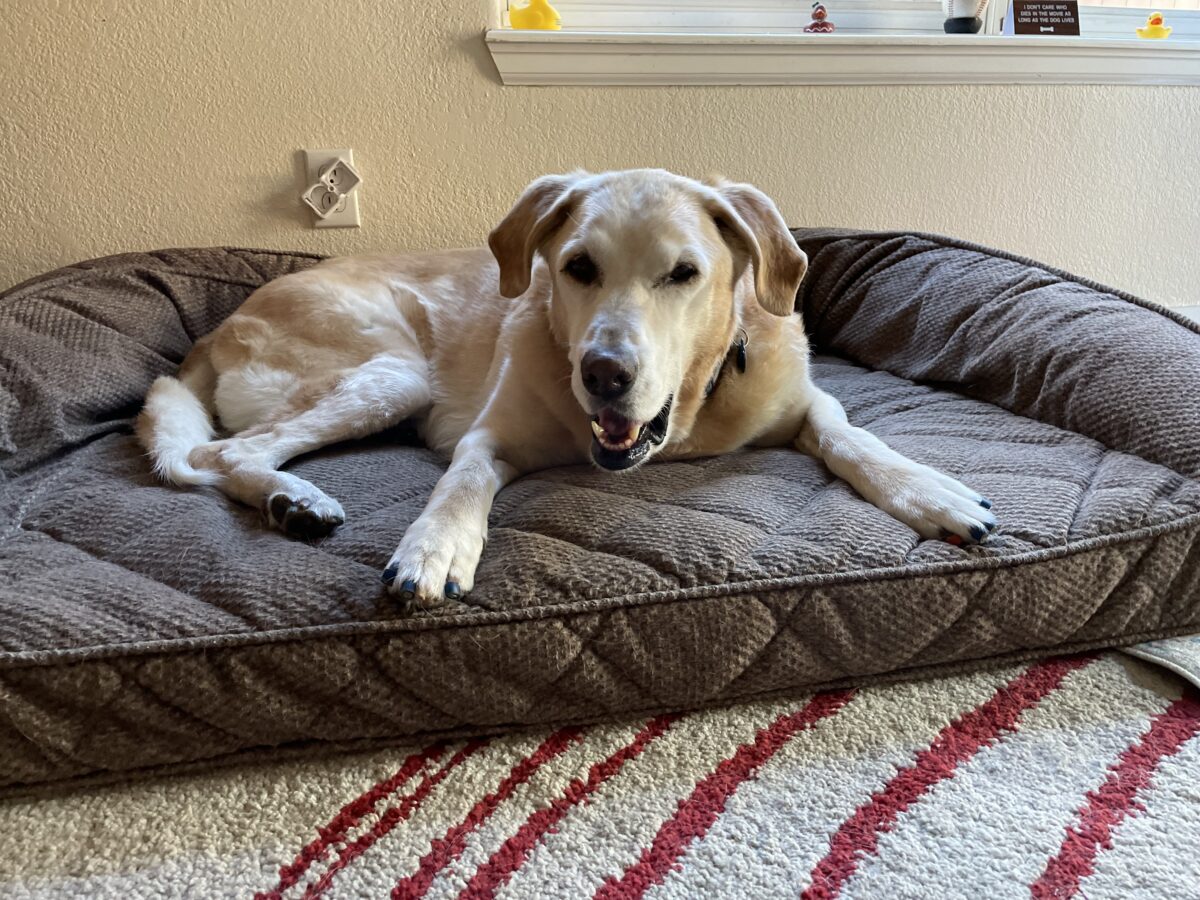It’s an immense privilege to have loved my Lab mix, Rio, for over 12 years. My husband and I adopted him from an animal shelter when he was just a few months old, and we’ve enjoyed each life stage – curious puppy, athletic adult, and now, sweet senior.
But it’s concerning to watch the dog who once bounded up hiking trails with the surefootedness of a mountain goat sometimes strain to rise from his bed – or lie down on a walk due to arthritis in his hips. We want to do all we can to help Rio enjoy his golden years.
Fortunately, there are many ways to help senior dogs with mobility issues – both at veterinary practices and at home, according to Andrea Y. Tu, DVM, a Fear Free certified veterinarian who is medical director of Behavior Vets of New York and a resident of the American College of Veterinary Behaviorists.
“The approach really involves multimodal pain management,” she says.
The individual needs of each dog vary, so your veterinarian will work with you to develop a plan. Dr. Tu said this may include one or more of the following:
- Pain medications such as nonsteroidal anti-inflammatory drugs (NSAIDs)
- Joint supplements such as Dasuquin Advanced complemented by Omega-3 fish oil
- Acupuncture (though not for pets with cancer)
- Laser therapy
- Referral to a veterinary rehabilitation facility for physical therapy exercises or walking on underwater treadmills to build up muscles
- Adequan injections to treat cartilage loss
- For smaller dogs with chronic hip pain, a surgery called femoral head ostectomy to remove painful bone-on-bone contact
Changes at Home
Dr. Tu recommends getting ramps that dogs can use to get on the sofa or bed. (Rio also uses one to get in and out of the car. For training tips, visit www.fearfreehappyhomes.com/ramps/). She’s a fan of ramps made of industrial-strength foam that can support weight without stubbing toes. (She even changes lightbulbs while standing on her pet’s ramp from Puppy Stairs.)
If your home has hardwood floors that dogs can slip on, she suggests Dr. Buzby’s ToeGrips, small rubber sheaths that encircle each toenail. She noted that every time an arthritic hip jerks or moves, it hurts, and used a vivid analogy to illustrate her point.
“If you force your grandmother who has arthritis in her hips to wear roller skates, that’s going to make things so much more painful. It is also going to add to her fear, anxiety, and stress because she doesn’t have stability,” she said. “So those toe grips not only help stability but help decrease some of those jerky movements that can add to the pain.”
Adhesives can help affix beds to the floor, and smaller dogs might also benefit on walking on yoga mats for traction.
Another non-invasive option for home care is the Assisi Loop, which uses targeted pulsed electromagnetic field therapy to reduce pain.
“You basically hit the button and put it over the joint of concern and it just automatically runs for 15 minutes, and you do it two or three times a day,” she says. “I had one patient who used to be on a nonsteroidal anti-inflammatory almost every day, and they were able to decrease it to once a week because they were using the Assisi Loop consistently.”
Dogs with back or neck pain might prefer elevated water and food bowls. Senior dogs can also benefit from orthopedic beds. Dr. Tu notes that DIY options include covering an egg crate mattress, or using one to replace the sagging foam in a well-worn dog bed.
She also advises taking shorter walks – and avoiding the “weekend warrior” syndrome that occurs when a dog overdoes exercise on a special outing. To compensate for shorter walks, you can increase enrichment activities, like scattering kibble in the grass or around the home for your dog to find. Smaller dogs might enjoy riding in a stroller.
Noticing the Signs
Any behavior change could mean a medical issue such as pain, so Dr. Tu recommends checking with your veterinarian any time you notice your pet behaving unusually. Even crankiness can be a symptom.
“If you’re anxious about pain – and there’s no creature who’s not going to be anxious and fearful of pain – that can display as any behavior change,” she says. “And pain and discomfort can come from any system in the body.”
It’s also a good idea to look for stress signs such as air licking and yawning, according to Dr. Tu. She compared air licking in a dog to a person picking their cuticles at the dentist’s office.
“It’s not because they’re worried about how their nails look. It’s because they’re nervous and they need an outlet for their nervous energy,” she says.
Ultimately, making changes to help our senior dogs feel as comfortable as possible aligns with the Fear Free goal of reducing fear, stress, and anxiety for pets.
“By addressing their pain and discomfort – and the anxiety and fear that result from a painful condition – we’re not only helping ensure that they are healthy from a physiological point of view, but also from an emotional or psychological one,” she says. “It’s all connected.”
This article was reviewed/edited by board-certified veterinary behaviorist Dr. Kenneth Martin and/or veterinary technician specialist in behavior Debbie Martin, LVT.
Award-winning journalist Jen Reeder is former president of the Dog Writers Association of America.
Want to stay in the loop on the latest and greatest in keeping your pet happy and healthy? Sign up for our free newsletter by clicking here!








